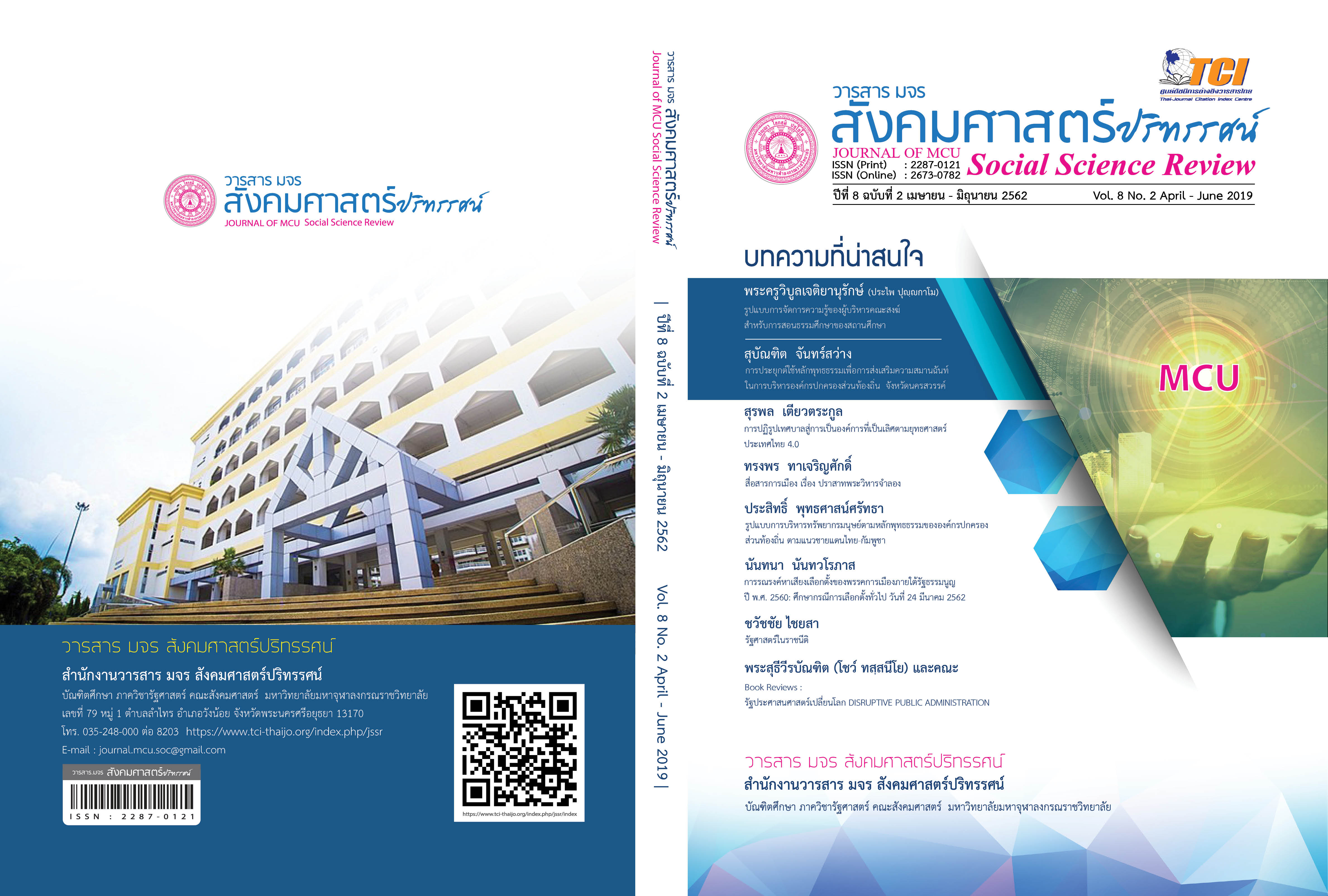อิทธิพลของพฤติกรรมนักท่องเที่ยวและการบริหารจัดการการท่องเที่ยวต่อความพึงพอใจแหล่งท่องเที่ยวบนเส้นทางอารยธรรมขอม
คำสำคัญ:
พฤติกรรมนักท่องเที่ยว, การบริหารจัดการการท่องเที่ยว, ความพึงพอใจบทคัดย่อ
การศึกษาเรื่องนี้มีวัตถุประสงค์เพื่อ 1) ศึกษาอิทธิพลของพฤติกรรมนักท่องเที่ยวและการบริหารจัดการการท่องเที่ยวต่อความพึงพอใจแหล่งท่องเที่ยวบนเส้นทางอารยธรรมขอม และ 2) เพื่อเปรียบเทียบความแตกต่างของรูปแบบการท่องเที่ยวต่อปัจจัยด้านพฤติกรรมนักท่องเที่ยว การบริหารจัดการการท่องเที่ยว และความพึงพอใจแหล่งท่องเที่ยวบนเส้นทางอารยธรรมขอม
การศึกษาครั้งนี้เป็นการวิจัยเชิงสำรวจ รวบรวมข้อมูลจากนักท่องเที่ยวที่เดินทางมาท่องเที่ยวเชิงนิเวศและเชิงประวัติศาสตร์ในแหล่งท่องเที่ยวบนเส้นทางอารยธรรมขอมในเขตพื้นที่จังหวัดนครราชสีมา ชัยภูมิ บุรีรัมย์และสุรินทร์ จำนวน 500 ตัวอย่าง โดยใช้แบบสอบถามเป็นเครื่องมือในการเก็บรวบรวมข้อมูล วิเคราะห์ผลโดยการแจกแจงความถี่ ค่าร้อยละ ค่าเฉลี่ย ค่าส่วนเบี่ยงเบนมาตรฐาน และทดสอบสมมติฐานด้วยการวิเคราะห์แบบจําลองสมการโครงสร้าง
ผลการศึกษาพบว่า
พฤติกรรมนักท่องเที่ยวและการบริหารจัดการการท่องเที่ยวมีอิทธิพลต่อความพึงพอใจแหล่งท่องเที่ยวบนเส้นทางอารยธรรมขอมอย่างมีนัยสำคัญทางสถิติ นอกจากนี้รูปแบบการท่องเที่ยวเชิงนิเวศมีความแตกต่างกับรูปแบบการท่องเที่ยวเชิงประวัติศาสตร์ โดยพบว่าพฤติกรรมนักท่องเที่ยวเชิงประวัติศาสตร์มีความสัมพันธ์กับการบริหารจัดการการท่องเที่ยวมากกว่ารูปแบบการท่องเที่ยวเชิงนิเวศ ดังนั้นเพื่อเป็นการสร้างความพึงพอใจให้กับนักท่องเที่ยวและส่งเสริมการท่องเที่ยวบนเส้นทางอารยธรรมขอมหน่วยงานที่เกี่ยวข้องควรให้ความสำคัญกับการพัฒนาการบริหารจัดการการท่องเที่ยวอย่างเป็นระบบและเน้นการประชาสัมพันธ์อย่างต่อเนื่องก็จะเป็นส่วนหนึ่งที่จะช่วยเสริมสร้างศักยภาพการท่องเที่ยวให้สูงขึ้น
เอกสารอ้างอิง
Chen, F. F., Sousa, K. H., and West, S. G. (2005). Testing measurement invariance of second-order factor models. Structural Equation Modeling 12(3): 471-492.
Department of Tourism. (2015). Tourism Destination Management Standard. Thailand’s standard tourism.
Field, A. P. (2005). Discovering statistics using SPSS (2nd ed.). London: Sage.
Gee, C. Y. and Choy. J. L. (1989). The Travel Industry. New York: Van Nostrand. 98.
Hair, J., Black, W., Babin, B., Anderson, R., & Tatham, R. (2010). Multivariate data analysis (7th ed.). New Jersey: Pearson Educational International.
Jittangwattana, B. and Wongpuntanan, P. (2014). Psychology and Quailty of Service Tourism. Bangkok. Chulabook center.
Kline, R. B. (2015). Principles and practice of Structural Equation Modeling (4th ed.). New York: Guilford publications.
Kotler Philip. (2003). Marketing Management. (11th ed.). New Jersey: Prentice Hall Inc. 95.
Management system certification institute (Thailand). (2007). A standard of tourism industry. Accessed, June 24, 2018. From: https://www.masci.or.th/services_other_th.php?servicesid=5& otherid=57
Nakhonchaiburin. (2017). Nakhonchaiburin chaem. Accessed: June 24, 2017, From: https://nakhonchaiburin.wordpress.com/
Parasakul, L. (2012). Tourist Behavior. Bangkok: Chulalongkorn University.
Ployrungroj, R. (2015). Tourist Behavior. Bangkok: Odeon store.
Rattanapong, T. (2015). Effects of engagement and satisfaction are more inclined to come back repeatedly. The attractions in the Province of Nakhon Si Thammarat. Thesis. Master of business administration (Tourism management). Prince of Songkla University.
Ringkananong, W. (2018). Ecotourism management model affects on satisfaction of Thai tourists in Wang Nam Khiao district, Nakhon Ratchasima Province. Independent Study. Master degree of business administration. Rajamangala University of Technology Isan.
Robinson and Etherington. (2006). Customer Layalty : A Guide for Time Travelers. New York : Palgrave Macmillan. 6-8.
Santos, J. R. A. (1999). Cronbach’s Alpha: A tool for assessing the reliability of scales. Journal of extension 37(2) : 1-5.
Schumacker, R. E., and Lomax, R. G. (2004). A beginner's guide to structural equation modeling (2nd ed.). Mahwah, NJ: Lawrence Erlbaum Associates.
Songsuk, S. (2014). Factor affecting Thai tourists’ satisfactions towards the tourist source management Phi Phi Don Island and Phi Phi Lay Island, Krabi Province. SSRU Gradute Studies Journal. 114
South Australian Tourism Commission. (2007). Design Guidelines for Sustainable Tourism Development. Retrieve August 16, 2007 from https://www.tourism.sa.gov.au/tourism.
Sripairoj, Q. and Silanoi, L. (2015), Tourists’ satisfaction on visiting retromarket: A case study of Talat KoKloi (KoKloi Retro Market) at Mueang district, Rayong Province, Thailand, Journal of Cultural Approach 16(30).
Suksanchananun, W. (2016). Tourists’ Expectation and Satisfaction of Home Stay Services at KOH-YOR. WMS Journal of Management 5(1), 60-73
Suksawang, P. (2014). The basics of structural equation modeling. Princess of Naradhiwas University Journal, 6(2), 136-145.
The official site of Tourism Authority of Thailand. (2009). Thailand’s travel information. Bangkok: Ministry of Tourism and Sports.
ดาวน์โหลด
เผยแพร่แล้ว
รูปแบบการอ้างอิง
ฉบับ
ประเภทบทความ
สัญญาอนุญาต
ลิขสิทธิ์ (c) 2019 วารสาร มจร สังคมศาสตร์ปริทรรศน์

อนุญาตภายใต้เงื่อนไข Creative Commons Attribution-NonCommercial-NoDerivatives 4.0 International License.
เพื่อให้เป็นไปตามกฎหมายลิขสิทธิ์ ผู้นิพนธ์ทุกท่านต้องลงลายมือชื่อในแบบฟอร์มใบมอบลิขสิทธิ์บทความให้แก่วารสารฯ พร้อมกับบทความต้นฉบับที่ได้แก้ไขครั้งสุดท้าย นอกจากนี้ ผู้นิพนธ์ทุกท่านต้องยืนยันว่าบทความต้นฉบับที่ส่งมาตีพิมพ์นั้น ได้ส่งมาตีพิมพ์เฉพาะในวารสาร มจร สังคมศาสตร์ปริทรรศน์ เพียงแห่งเดียวเท่านั้น หากมีการใช้ภาพหรือตารางหรือเนื้อหาอื่นๆ ของผู้นิพนธ์อื่นที่ปรากฏในสิ่งตีพิมพ์อื่นมาแล้ว ผู้นิพนธ์ต้องขออนุญาตเจ้าของลิขสิทธิ์ก่อน พร้อมทั้งแสดงหนังสือที่ได้รับการยินยอมต่อบรรณาธิการ ก่อนที่บทความจะได้รับการตีพิมพ์ หากไม่เป็นไปตามข้อกำหนดเบื้องต้น ทางวารสารจะถอดบทความของท่านออกโดยไม่มีข้อยกเว้นใดๆ ทั้งสิ้น





